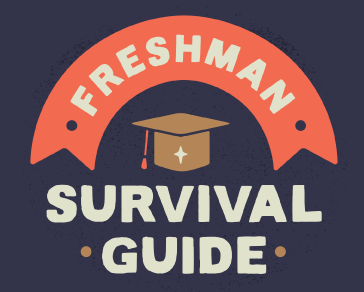Don’t Have Time to Count Calories! Besides, I Just Don’t Care That Much:
Avoiding the Freshman 15 (or at least turning it into the Freshman 5)
by Monica Bradbury
If your mom always fed you good healthy balanced meals at home and you really never had to think about what you were eating before, you might feel clueless when you walk into a dining hall, especially if your meal plan is “all you can eat.” Here are three simple rules to follow if you aren’t interested in doing math with your dinner (weighing, measuring, and counting calories and nutrients), but you still want your jeans to fit.
1. Notice your food. You don’t have to become a nutritional researcher, but you do have to start paying a little bit of attention to what you eat. This includes things like portion control (“OMG, there’s a frozen yogurt machine in the cafeteria? I want SIX!”) as well as emotional eating (post-breakup chocolate or anti-homesickness-care-package-chocolate-chip cookies still count as food) and mindless munching (vegging out in front of the TV with a plate of veggies and dip…or studying with a bag of chips). You’ve probably heard the saying “you are what you eat,” but just as important are when, why, and how much you are eating.
2. Keep your food safe. Foodborne illnesses are a real risk, especially when eating out or preparing food in a shared kitchen. Make sure to follow proper food safety practices, such as washing your hands before cooking, using separate cutting boards for raw meats and vegetables, and storing leftovers in airtight containers in the fridge. Additionally, consider investing in food safety test kits to ensure that your food is free of harmful bacteria like E. coli and salmonella. By taking these precautions, you can help prevent foodborne illness and keep yourself and those around you healthy.
3. Eat your veggies! And all the other food groups! If you choose one portion from each food group at every meal it’s hard to go wrong here. Remember in elementary school when you would eat your pizza first, then eat your mandarin oranges, drink your chocolate milk, and stare at that pile of green beans in the corner of your tray until recess? Here’s a tip: eat your vegetables first, when you’re hungriest and they are still hot, then move on to the rest of your meal. There’s a reason restaurants always bring the salad first.
4. Eat raw! The closer your food looks to how it came out of the ground, the better. Processing removes all the healthy stuff and adds bunches of stuff that’s not good for you. That doesn’t mean you have to eat all your carrots cold and raw, but try to fit in some fresh fruit every day (apples and bananas make a great take-along snack for between classes). You can’t really tell just by looking at a loaf of bread or a plate of pasta that these things were ever a plant, so limit these. Replace your morning cinnamon roll with a bowl of oatmeal and fresh fruit. Same goes for meat, even if this sounds gross: if it still looks like a muscle, that’s good (think beef steak or chicken breast). If it’s been chopped up, recombined, and molded into shape (think dinosaur nuggets or hot dogs), chances are it’s not very good for you.
Happy eating!

